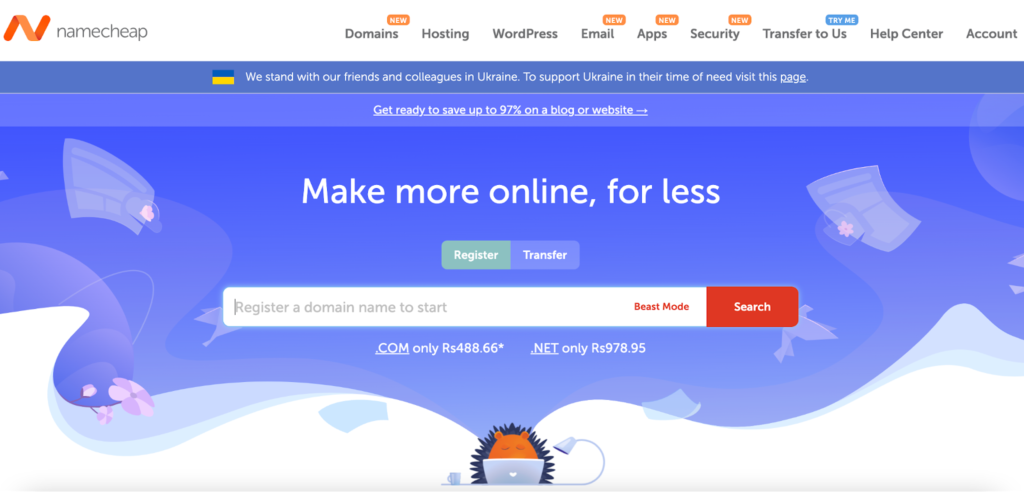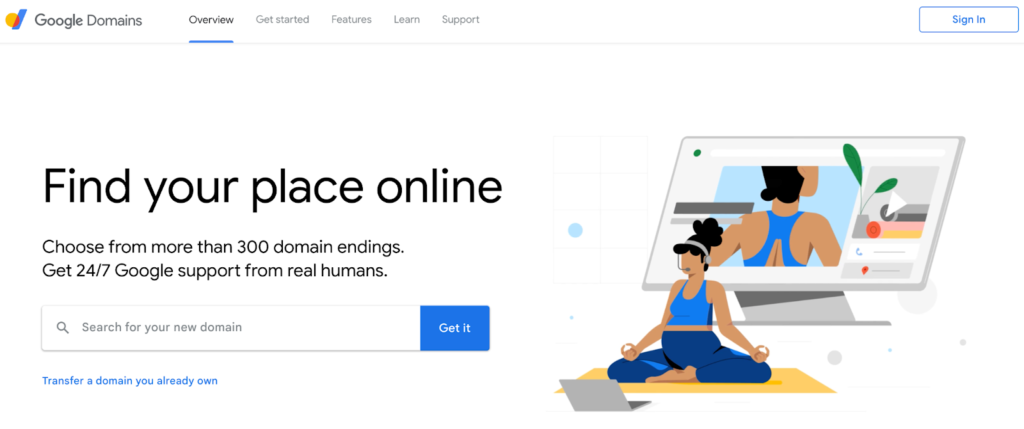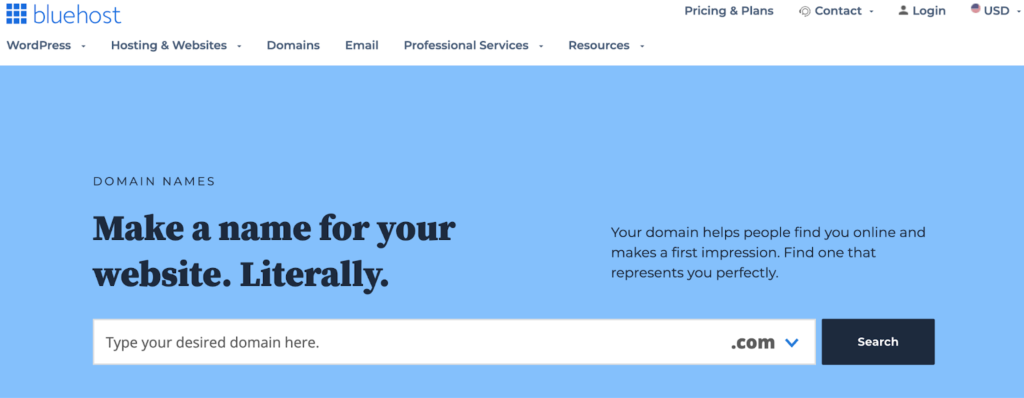The first step to building a successful online brand is selecting the right domain name. Many beginners struggle in this initial stage, leading to potential failure.
Choosing an SEO-friendly domain name requires careful thought and consideration. It is not a simple task and often requires time and effort.
Selecting the wrong domain name can result in the loss of search traffic and revenue. Worst-case scenario, Google may even label your website as spam.
So how do you choose the code domain name for your website?
Similarly, you might have several other questions regarding domain names and might be wondering where you can get answers to all of them.
But don’t worry. We have got you covered.
In this article, we will share eight tips to help you select an SEO-friendly domain name for your new website. We will also compare selecting a free vs. paid domain name and finally provide a step-by-step guide on registering your domain name. So, without any further ado, let’s get started.
What is a domain name?
Your website’s online identity is referred to as a domain name, which is the name that people enter into their web browsers to access your site.
The domain name has two parts: the first part, before the dot sign, is the domain, and the second part, after the dot sign, is the domain extension.
For instance, in the domain name “JeffBullas.com,” “JeffBullas” is the domain name, and “.com” is the domain extension.
When registering a domain name, you must choose both the domain name and extension based on the type of website you have.
How to choose an SEO-friendly domain name?
Selecting an SEO-friendly domain name is essential for optimizing your website’s visibility in search engine results. Consider incorporating relevant keywords, keeping it concise, and making it memorable for your website visitors. A well-chosen domain name can help improve your website’s organic search rankings and attract targeted traffic.
Here are the top 8 factors you should consider for choosing an SEO-friendly domain name:
1. Use top-level domain extensions
Before purchasing a domain name, it is important to know which domain extension is suitable for your website or business.
The domain name system offers over 1,000 domain extensions, which can make choosing one a confusing task. According to research, more than 49% of all domain names have the “.com” extension, but other popular options include “.net,” “.org,” “.edu,” “.info,” and many more.
Top-level domains (TLDs) include “.com,” “.net,” “.org,” and “.edu.” However, if you plan to start a blog, business, or any other profitable website, it is recommended to choose the .com extension, which is the most popular and widely recognized.
While some may wonder if choosing a particular domain extension has SEO benefits, the truth is that the only thing that matters in a domain name is the domain itself and not the extension.
Extensions were created to differentiate between different types of websites. For instance, .com is used for commercial businesses or profitable websites like Apple.com. .net is used for networking-related websites like slideshare.net, while .edu is used for education-related websites like harvard.edu. Non-profit organizations mostly use the .org extension, like Wikipedia.org.
If you have a website for profit-making, it’s better to go with the .com domain. Keep in mind that the .com extension is the most popular, and it can be difficult to find good domain names that are still available. In such cases, you may have to get creative and come up with new domain names or opt for alternative extensions like .net or .org.
2. Go for brandable domain names
Have you ever wondered why some websites always rank higher than others? It’s because they have established themselves as a brand. Search engines such as Google use “brand signals” to identify high-quality websites and give them priority in search results.
But what makes a domain name brandable? There are several factors to consider, such as:
- Uniqueness: A brandable name is unique and doesn’t have a specific meaning, like “Google.com”
- Simplicity: It should be simple and easy to remember.
- Pronunciation: The domain name should be easy to pronounce.
- Stand out: It should stand out from the competition.
- Short and memorable: A shorter domain name is usually easier to remember and more brandable. For example, “Apple.com” is a more brandable domain than “TheNewBrandApple.com”
If you are having trouble coming up with a brandable domain name, you can try adding relevant keywords or suffixes. However, make sure the new domain sounds like a brand and meets the above criteria. You can assess your domain name value based on factors like domain age, keywords, brandability, and market demand.
3. Keep your domain name short
Keeping your domain name short is essential. Short domain names are easier to remember and pronounce. Many successful companies have short names like Google.com, Amazon.com, Twitter.com, and Facebook.com.
According to a study, the most common domain name length is about 12 characters. We recommend that you keep your domain name between 6-14 characters.
For instance, the domain name “JeffBullas.com” has exactly 10 characters.
4. Avoid numbers and hyphens in your domain name
If you are aiming for better SEO when choosing a domain name, it is advisable to steer clear of using hyphens and numbers.
Using numbers and hyphens in a domain name can make it harder to pronounce and less memorable.
Take the example of Apple.com. It is a short and easy-to-pronounce domain name that sounds like a brand. If it had included hyphens or numbers, such as “App-le.com” or “Number1Apple.com”, it might not have achieved the same level of recognition and popularity.
Therefore, when selecting a domain name for your website, it’s best to keep it as simple as possible and avoid using hyphens and numbers.
5. Ensure it’s easy to type and memorable
Selecting a domain name that is easy to remember is crucial for achieving success online. A complex domain name such as aabcmysitee.com can be difficult for users to type and remember.
If visitors want to revisit your website, they may struggle to remember your domain name, resulting in lost traffic and revenue. Successful sites and companies tend to choose simple domain names that are easy to spell, such as Google.com, Facebook.com, Twitter.com, and others.
6. Don’t use repeated letters
When buying a domain, it’s important to avoid using repeated letters, keeping it simple and straightforward.
For instance, let’s compare two domain names: “flowershop.com” and “floowershoop.com”. The first domain name is good because it’s simple and easy to remember. On the other hand, the second domain name contains repeated letters which can cause confusion among visitors.
Although many of the best domain names are already taken, it’s not a good idea to use a brand name with repeated letters just. Make sure that your domain name is unique and easy to spell so that visitors can easily find your website.
7. For new domain ideas, use domain name generators
It’s no surprise that many desirable domain names have already been registered.
Fortunately, there’s a solution: domain name generators. These tools can generate thousands of domain names for you by automatically appending relevant and commonly used suffixes.
One example of such a domain name generator is NameCheap. Before finalizing your domain name choice, check domain name availability through a reliable registrar.
If you are curious about who owns a domain name, you can perform a domain name look-up using various WHOIS lookup services available online.
8. Add a keyword to your domain name
If you have some knowledge of search engine optimization (SEO), you may already know the importance of keywords. Typically, when creating a webpage, you will include keywords in the title, meta description, URL, and several times throughout the content.
Why not consider incorporating a keyword into your domain name as well? Although it won’t provide any specific SEO benefits, it may help increase your search traffic by attracting more clicks to your listing.
For instance, if you are a web developer, a suitable domain name with a keyword could be “webdevs.com”.
To register a domain name, compile a list of a few that match your business, or you may use a domain name generator tool if necessary. Conduct a domain name search to explore available options that align with your website’s purpose and brand. Additionally, it is preferable to register your domain name with the most popular extensions that we discussed earlier, if possible. Keep in mind that if you delay registering your domain, someone else will snatch it up. Proceed to buy a domain name from a reputable registrar once you have found the ideal domain name.
What to choose: Free or paid domain names?
There are two ways to obtain a website domain before creating your website: reserving it through a hosting service provider or using website builders such as Wix or Foursquare.
With website builders, you can launch your website with minimal effort and without much technical knowledge. However, in this case, your website will be hosted on a sub-domain, such as “yourwebsite.wix.com,” which is not ideal for building a long-term business or a strong brand. There are two primary drawbacks to this approach:
- You do not own the sub-domain name, and it is not portable.
- Your website domain will be longer and will contain “wix” or “foursquare” in the middle instead of a simple and easy-to-remember domain name like yourwebsite.com.
Despite these disadvantages, it is worth examining the pros and cons of this approach to determine if it is the right choice for your needs.
Advantages of free domains
- Free yearly usage: If you are new to domain registration or are unsure about how it works, a free domain can serve as a playground and workshop for you for the entire year.
- One-time usage: If you are organizing an event (like a local festival, competition, or party), a free domain can be used just for that event and be relevant for a short period of time. Save money and focus on the event itself rather than worrying about creating a domain name.
- Option for bloggers: If you have a personal blog for sharing thoughts, hobbies, or a diary, a free domain can be a good choice.
- Short-term websites: If you are not sure whether your blog or service will last for more than a year, using a free domain for up to 12 months is a sensible decision.
- Cost-efficient: If you need to launch your website quickly due to some serious reason but don’t have the money to purchase a domain name, a free domain can come to your rescue.
Disadvantages of free domains
- Limited service: Free domains are often given as bonuses, and you will be charged later (usually after a year). If you are planning a long-term project, retrenching by using a free domain won’t be useful.
- SEO issues: Sub-domains are not easily indexed by search engines, which means you have a low chance of building a recognizable brand. It’s possible that you may never be found.
- Unexpected issues: If you decide to switch to a paid option later and enjoy its full functionality, be prepared to start all over again with no visitors, backlinks, SEO settings, or achieved rankings.
How to buy a domain name?
When it comes to buying a domain name, GoDaddy is the most popular service that offers many special deals for first-time registration. These packages include some essential features, such as privacy settings but with a price tag.

If you are looking for a domain name registration service that offers lower prices and a better selection of additional features, Namecheap is a good option. For instance, you can benefit from private domain registration for free for the first year.

Google Domains provides a fair selection of extensions, reasonable prices, and a simple interface for domain name registration. However, this service does not offer extra features and services.

Bluehost provides a free domain for a year, and they are one of the best web hosting companies available, powering over two million websites worldwide. They are also officially endorsed by WordPress.org. Typically, a domain costs about $14 per year, and web hosting costs $11 to $14 per month, which can be quite expensive if you are just starting out.
Fortunately, Bluehost offers a 60% discount on their hosting plans. You can register a domain for free for one year with Bluehost, and they provide almost all top-level domain extensions, such as .com, .net, .org, .info, and many more. Additionally, their hosting plan includes a free SSL certificate, unlimited bandwidth, and other features.

In addition to the aforementioned services, there are also other trusted and popular services available such as Hover, Porkbun, HostGator, Domain.com, InMotion Hosting, Eukhost, and HostPapa.
Every hosting provider will have a step-by-step guide listed on their website on how to register a domain name from them. Follow the guide to ensure a smooth and hassle-free process when registering your domain name.
You can complete the domain name registration process by providing the necessary information and payment to secure your chosen domain.
Step-by-step guide on how to register a domain name
Let’s break down the domain name registration process into seven simple steps that you can use as a guide in the future:
Step 1: Choose a unique, catchy, relevant, easy-to-write, and memorable name for your domain. If you can’t come up with one, you can use a domain name generator.
Step 2: Decide on a suffix that reflects either the geographical location or field of your business. However, .com is a popular choice and is used for almost everything these days.
Step 3: Determine the timing of your domain registration. The name is often included in the first year of hosting, and you will need to renew it every year or so. Some providers offer payment options for five or ten years.
Step 4: Choose a service provider that offers the best plan for you. Check out the options from the list above and select the one that fits your needs.
Step 5: Check the availability of the name. Many good names are already taken, so ensure that the name is available before making big plans. Claim it immediately if it’s available. If the domain name is not available, you can consider purchasing it with an alternative suffix.
Step 6: Register the domain. The process is similar to registering an email account or social media profile.
Step 7: Wait for the domain to be activated. Some domain registrars claim that they will activate the domain immediately, but it usually takes 48 hours or less.
Step 8: Keep track of the domain. Remember to renew your domain name before it expires; otherwise, the hosting provider may turn it off or sell it to someone else.
Conclusion
The value of a domain is determined by several factors, including its uniqueness, relevance, age, history, and popularity. It’s crucial to choose the right domain name that reflects your business, brand, or personal identity and makes a lasting impression on your target audience.
You should also pay attention to the terms and conditions of the domain registration, the technical specifications of your website, the hosting company’s specialization, and the scalability options. By following the domain registration plan we outlined above, you can save time, money, and effort and enjoy a smooth and successful online presence.
Remember, your domain name is not just an address but an identity. It’s what people will remember you by and how they will find you online. Therefore, invest in it wisely, and don’t compromise on quality for the sake of price. A great domain name can be a game-changer for your business, a source of inspiration for your creativity, and a legacy for future generations.
So, go ahead and unleash your imagination, search for your dream domain, and claim your place in the digital world. Who knows, maybe one day, your domain name will become the next big thing, and everyone will be talking about it.